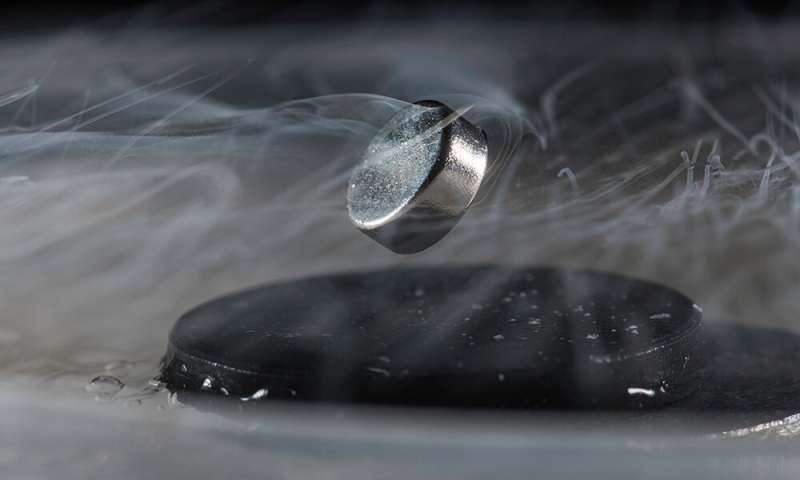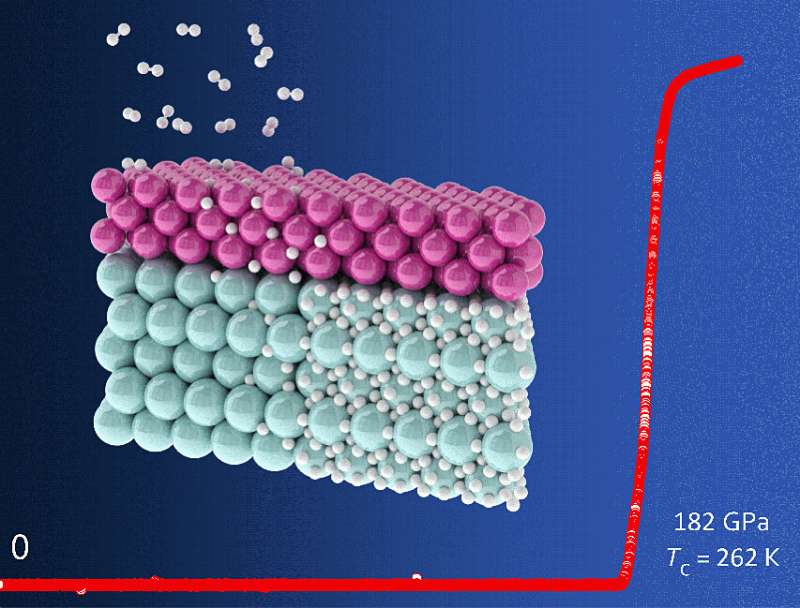The goal of new research led by Ranga Dias, assistant professor of mechanical engineering and of physics and astronomy, is to develop room temperature superconducting materials. Currently, extreme cold is required to achieve superconductivity, as demonstrated in this photo from Dias's lab, in which a magnet floats above a superconductor cooled with liquid nitrogen. Credit: University of Rochester photo/J. Adam Fenster
A team of researchers from the University of Rochester, the State University of New York at Buffalo and the University of Nevada Las Vegas has reduced the amount of pressure required to force a material to become superconductive at room temperature, improving on their own previous results. In their paper published in the journal Physical Review Letters, the group outlines their technique and plans for the future.
Scientists have been looking to create materials that are superconductive at room temperature for many years. Such a material would allow for building cooler electronics and would dramatically increase the efficiency of the electricity grid. It was not until late last year that the first such material was created—a hydrogen-rich compound that, when squeezed to 267 GPa, became superconductive. And while the feat was a step in the right direction, the need for high pressure made the material impractical for everyday use. In this new effort, the same team has found a way to dramatically reduce the required pressure by making a change to their prior technique—they combined hydrogen with yttrium instead of carbon and sulfur.
Prior research had shown that materials with a high hydrogen content lend themselves well to superconductive materials created under higher temperatures and that was why they had chosen it for their experiments.
The work involved using two diamond anvils to create the pressure. They were placed slightly apart with hydron gas and a sample of yttrium in its solid state between them. The materials were separated by a sheet of palladium, which the team added to prevent oxidation of the yttrium—it also served as a catalyst, aiding in moving the hydrogen atoms into the yttrium. Testing of the resulting material showed it to be superconductive at 182 GPa—much lower than they found last year, but still much too high for practical use. They suggest that they are moving in the right direction, however, and plan to continue revising their technique to learn more about its potential—and, of course, to find out if it could be used to create a room temperature superconductive material.
This illustration from the Dias lab shows hydrogen molecules, at top, diffusing into a thin layer of palladium (purple), where they are separated into individual atoms, which then are distributed in an underlying layer of yttrium. Credit: Ranga Dias lab/University of Rochester
More information: Elliot Snider et al. Synthesis of Yttrium Superhydride Superconductor with a Transition Temperature up to 262 K by Catalytic Hydrogenation at High Pressures, Physical Review Letters (2021). DOI: 10.1103/PhysRevLett.126.117003
On Arxiv: arXiv:2012.13627v1 [cond-mat.supr-con] arxiv.org/abs/2012.13627
Journal information: Physical Review Letters , arXiv
© 2021 Science X Network

























